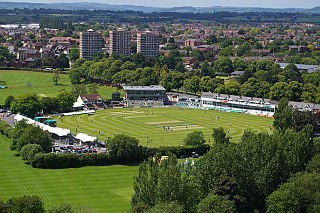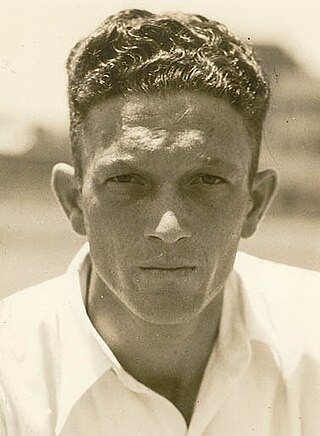The 2005 English cricket season was the 106th in which the County Championship had been an official competition. Before it began, a resurgent England cricket team had won four Test series in a row, going unbeaten through the 2004 calendar year. The start of the international season saw England defeat Bangladesh 2–0 in their two-match series, winning both Tests by an innings. This was followed by a tri-nations one-day tournament that also featured Australia. Australia still started the Test series as favourites but most fans expected England to put up a challenge.
Essex County Cricket Club played their cricket during the 2005 season in Division Two of the County Championship and Division One of the Sunday League. They started the season 8–1 to win the Second Division Title, and were second in the Championship table at 9 May, but five matches without a win following that sent them down to fifth place at the Twenty20 break in June. They only intermittently broke into the top three after the Twenty20 break, and when they did their opponents behind them usually had a game in hand. They finished fifth, 15.5 points behind the promotion spot, and with 36 bowling points they picked up the fewest in the entire Division Two. In the National League, however, they only lost once in sixteen games – against Gloucestershire Gladiators in August – and won the League on 28 August with three games to play. In the C&G Trophy, they went out to Lancashire at the second round stage, while they finished fifth in the group stage of the Twenty20 Cup, two points off a guaranteed quarter-final spot.
Northamptonshire County Cricket Club in 2005 are playing their cricket in Division Two of the County Championship and Division One of the totesport League. They started the season at 12–1 to win the Division Two title. During the off season 9 players left.
The MCC University matches in 2005 are games played between the University Centre of Cricketing Excellence ("UCCEs") and first-class opposition. This is the first year the games are called "MCC" University matches, after the MCC announced a funding plan to support the development of student cricket.
Derbyshire County Cricket Club in 2005 was the cricket season when the English club Derbyshire had been playing for one hundred and thirty-five years. They reached the semi-final in the Cheltenham and Gloucester Trophy. In the County Championship, they finished ninth in the second division and in the National League, they finished sixth in the second division. They were eliminated at group level in the North section of the Twenty20 Cup.

New Road is a cricket ground in the English city of Worcester. It has been the home ground of Worcestershire County Cricket Club since 1896. Since October 2017 the ground has been known for sponsorship purposes as Blackfinch New Road following a five-year sponsorship arrangement with Blackfinch Investments.
Gerald Arthur Smithson was an English cricketer who played in two Tests for England in 1947–48. He was born at Spofforth, West Riding of Yorkshire and died at Abingdon, Oxfordshire.

Roy Kilner was an English professional cricketer who played nine Test matches for England between 1924 and 1926. An all-rounder, he played for Yorkshire County Cricket Club between 1911 and 1927. In all first-class matches, he scored 14,707 runs at an average of 30.01 and took 1,003 wickets at an average of 18.45. Kilner scored 1,000 runs in a season ten times and took 100 wickets in a season five times. On four occasions, he completed the double: scoring 1,000 runs and taking 100 wickets in the same season, recognised as a sign of a quality all-rounder.

When the First World War ended in November 1918, thousands of Australian servicemen were in Europe as members of the First Australian Imperial Force (AIF) and many remained until the spring of 1919. In England, a new first-class cricket season was planned, the first since 1914, and an idea that came to fruition was the formation of an Australian touring side made up of servicemen. Agreement was reached with the Australian Corps HQ in London, commanded by Field Marshal William Birdwood, 1st Baron Birdwood, and the Australian Imperial Force Touring XI was formed, initially under the captaincy of pre-war Test player Charlie Kelleway. Kelleway departed after only six matches following a dispute about the fixtures list. A players' meeting elected future Test player Herbie Collins as team captain for the remainder of the tour, despite the fact that Collins' military rank was lance corporal and there were seven officers in the party. The bulk of the team remained intact for nearly nine months from May 1919, playing 33 matches in Great Britain, ten in South Africa on their way home and then another three in Australia itself before disbanding in February 1920. Of the 46 matches, 39 are adjudged first-class and the team had only four defeats, all of these in England. The players lived on their army pay and all profits from gate money went to an AIF Sports Control Board.
The 2006 English cricket season was the 107th in which the County Championship had been an official competition. It included home international series for England against Sri Lanka and Pakistan. England came off a winter with more Test losses than wins, for the first time since 2002-03, but still attained their best series result in India since 1985. The One Day International series against Pakistan and India both ended in losses.
1939 was the 46th cricket season in England since the introduction of the County Championship in 1890. It was the one and only season in which English cricket adopted the eight-ball over. 1939 was the last season before the Second World War and it was not until 1946 that first-class cricket could resume in England on a normal basis. The West Indies were on tour and England won the Test series 1–0. The West Indian team departed early, with several matches cancelled, because of the growing international crisis.
The County Ground in Southampton, England, was a cricket and football ground. It was the home of Hampshire County Cricket Club from the 1885 English cricket season until the 2000 English cricket season. The ground also served as the home ground for Southampton Football Club from 1896 to 1898.
1947 was the 48th season of County Championship cricket in England. It is chiefly remembered for the batting performances of Denis Compton and Bill Edrich who established seasonal records that, with the subsequent reduction in the number of first-class matches, will probably never be broken. Their form was key to their team Middlesex winning the County Championship for the first time since 1921, although they were involved in a tight contest for the title with the eventual runners-up Gloucestershire, for whom Tom Goddard was the most outstanding bowler of the season. Compton and Edrich were assisted by the fact that it was the driest and sunniest English summer for a generation, ensuring plenty of good batting wickets.

The Australian cricket team toured England during the 1902 English cricket season. The five-Test series between the two countries has been fondly remembered; in 1967 the cricket writer A. A. Thomson described the series as "a rubber more exciting than any in history except the Australia v West Indies series in 1960–61". Australia had won the previous three Test rubbers between the two countries, and now won their fourth successive series, by two matches to one with two draws. In the process they "beat the records of all their predecessors in the country" by losing only two of 39 matches during the tour, their defeats being against England in the Fifth Test and in the first of their two fixtures against Yorkshire. The remaining 37 matches gave 23 wins for Australia and 14 draws.
The Parsi tour of England in 1886 was the first cricket tour of England by a team from India. While the tour was singularly unsuccessful in terms of results, it paved the way for another trip by the Parsis two years later and more tours by English teams to India in the next decade.
The Circle was a cricket ground on Anlaby Road in Kingston upon Hull, which hosted 89 first-class matches from 1899 to 1974. Two other matches were rained off without a ball being bowled. Most of the matches were County Championship games featuring Yorkshire County Cricket Club, but matches against touring teams from India, Australia, South Africa and University games were also played there. 19 List A one day games were also played at the venue from 1969 to 1990.

Don Tallon was a key member of Donald Bradman's famous Australian cricket team tour of England in 1948, in which Australia was undefeated in their 34 matches. This unprecedented feat by a Test side touring England earned them the sobriquet The Invincibles.

During the seven years 1933 to 1939, Herbert Sutcliffe played throughout the period for Yorkshire during one of the club's most successful phases. His Test career ended in 1935 but he formed a new opening partnership for Yorkshire with the young Len Hutton. In 1939, he was the first Yorkshire player to be called up for military service as the Second World War loomed.

Headingley Cricket Ground is a cricket ground in the Headingley Stadium complex in Headingley, Leeds, England. It adjoins the Headingley Rugby Stadium through a shared main stand, although the main entrance to the cricket ground is at the opposite Kirkstall Lane end. It has hosted Test cricket since 1899 and has a capacity of 18,350.







